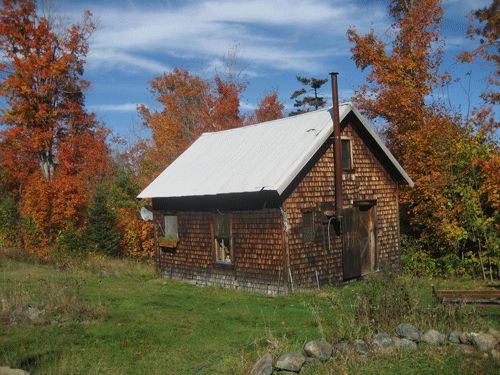
NOTE: "Semi-Rough: A North Country Journal," is now available as a complete book, that includes these on-line essays and more. If you'd like a free pdf to download to your computer, send me a note at symbios@condortales.com and I'll email you a copy.
Sunday 5 Oct 1997 - "Two hunting parties drove in and out in the morning. One man was from Berlin, who had hunted here before but had never found anyone around to ask permission of. Dennis sent him down to 'the Professor's place' - he asked if I was 'the Professor'."
When Sally's folks bought our Dummer Hill property from Edgar and Mildred Bacon in 1947, they named the place "Arriba" - a Spanish word which could be translated to something like "up yonder". (It can also be used as an exclamation - Oh, Wow! - which fits, also.) The binder that holds our journals is labeled "Arriba", but to us and our kids the place has always been just "Camp".
Although "Camp" was registered in our name for many years, I don't think anyone has ever called it "the Wilburs". To local folks, it is sometimes "the Harris place" [Sally's family name], or "Mrs. Harrises" -from all the years that Sally's mom, the petite gray-haired "Cal" Harris, spent there by herself. But most often - and it still amazes me how widespread the usage is - it is simply "the Professor's place".
Sally's dad, Stuart K. "Slim" Harris, was on the staff of Boston University, where for many years he taught courses in botany and ornithology . Tall, slim (like his nickname) and professorial, he used Camp as a family vacation spot, a personal retreat, and a kick-off point from which to explore the natural wonders of the Hill and the nearby mountains. From Camp, he worked with Professor Pease to expand and revise the flora of Coos County. He drew all the pictures and was the principal author of "Mountain Flowers of New England", the Appalachian Mountain Club best-seller still in use today, almost forty years after first publication. He and wife Cal started the popular flower walks in the Alpine Garden on Mt. Washington. Each winter, Slim participated in the nationwide Christmas Bird Count by doing a rugged and innovative snowshoe loop of Dummer Hill, adding the few hardy birds he saw to the national totals. Sally says he took one day just to break a trail through the woods and deep snows, then did the actual count over the same route the next day.
All this might have been a little off-putting to folks in the North Country - an academic type from "below the notches" setting up shop in the Dummer wilds. But it wasn't. He was a good mixer, whose interests were not above and beyond the interest of others. That first summer on the Hill - when the family had no motor vehicle - he must have become a familiar figure as he regularly walked the five miles from Camp to the store in West Milan Village, then back again, pack on back, bringing in the family staples of hot dogs, beans and Dinty Moore stew. He had lots of time to socialize along the way, and soon many residents of West Milan, Dummer Corner and Dummer Plain knew "the Professor" from Dummer Hill.
Slim's last summer on Dummer Hill was 1968; he died in 1969. Most of the Coos County people who actually knew him are gone, too, and most who come looking for "the Professor's place" nowadays probably have no idea who "the Professor" was.
It's fun to be associated with a place name that, although not on any map, has a tradition of usage that spans several generations. There aren't many of them around Dummer Hill, anymore. Children of local families, and those who have hunted the area for years, still know "Neil Coates' Field" [the no longer open meadow area - sometimes called "the Hart Place" - between Cummings Mountain and the powerline crossing of the Dummer Hill Road], but how many know "Llewellan's", "the log cabin", "the Trafton Place", or even "the Big Spring"? How many people know that the Easton Rod and Gun Club building on the Dummer Hill Road was "the Lovejoy place", one of the early homes in the area? Who in the future will know about the cellarhole [wonderfully preserved until an irresponsible logger skidded trees through it] where once stood the home of John Bickford and Martha (Lang) Lovejoy, where Mrs. Lovejoy [the great grandmother of Becky (Emery) Mullins and Sarah (Emery) Cordwell] spent long days alone with her children, waiting for husband John to return from the Civil War? And for how many more years will folks come looking for "the Professor's Place"?
To the Writing It Down Homepage
Leave a Comment: symbios@condortales.com